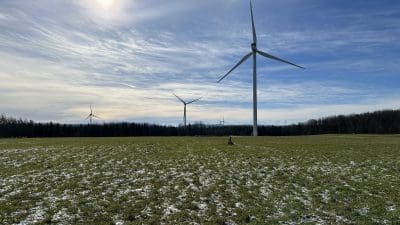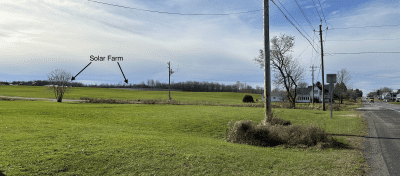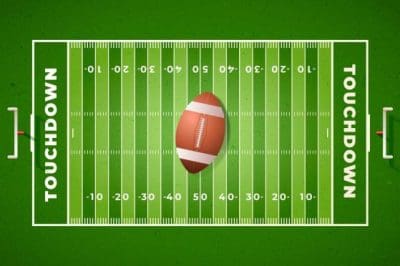Comparison of Wind Turbine and Solar Farm Project
In the choice section of the survey, you will be asked to make a series of choices between different renewable energy projects. These projects, whether wind or solar, have various attributes.
Before getting started with the actual choices, we'd like you to gain knowledge about wind and solar projects and their attributes as we use them in this survey.
Attribute 1 Renewable Energy Sources:
(1) Wind farms: A group of wind turbines in the same place, producing electricity. This study is focusing on onshore (terrestrial) wind farms located on fields or hills.
 Noble Ellenburg Wind Park, Clinton County, New York (54 Turbines - 81 MW). The first turbine is 0.18 miles (978.1 ft), Second 0.50 miles, Third 1 mile away, and the turbines behind trees 1.6 to 2.7 miles away from the road
Noble Ellenburg Wind Park, Clinton County, New York (54 Turbines - 81 MW). The first turbine is 0.18 miles (978.1 ft), Second 0.50 miles, Third 1 mile away, and the turbines behind trees 1.6 to 2.7 miles away from the road
(2) Solar farms: A group of solar PV panels placed on farms on the ground in an open space to capture the energy from the sun and convert it into electricity. We are not referring to rooftop solar installations.
 Solar farm 0.20 miles away
Solar farm 0.20 miles away
Attribute 2 Landscape – Visual Impact:
The visual impact can be defined as the effect that the renewable energy facility has on nearby views from your community under good daytime visibility conditions. We will ask you to consider three levels of visual impact as follows.
The visual impact of wind farms:
(1) Low Impact: You can rarely see the wind turbines, or they provide minimal impact on the viewshed.
 Munnsville Wind Project, Madison County, NY (23 Turbines - 34.5 MW). Turbines are on hills 4.5 miles away from the road
Munnsville Wind Project, Madison County, NY (23 Turbines - 34.5 MW). Turbines are on hills 4.5 miles away from the road
(2) Moderate Impact: You can see some of the wind turbines.
 Noble Chateaugay Wind Park, Franklin County, NY (71 Turbines - 106 MW). Turbines 1.3 to 2.1 miles away from the road
Noble Chateaugay Wind Park, Franklin County, NY (71 Turbines - 106 MW). Turbines 1.3 to 2.1 miles away from the road
(3) Major Impact: You can clearly see many wind turbines.

Noble Chateaugay Wind Park, Franklin County, NY (71 Turbines - 106 MW). The first big turbine is 0.2 miles away, and behind that 0.3 to 1.2 miles away from the road.
The visual impact of solar farms:
(1) No Impact: You cannot see the solar farm even if it is close to your property or a road. [Solar collection devices tend to be only about 10 feet tall and solar farms are often surrounded by trees, so that the visual impact of the solar farm on the nearby community is quite minor.]

 Solar farm behind trees, and it is 0.22 miles away from the road.
Solar farm behind trees, and it is 0.22 miles away from the road.
 Solar farm 0.26 miles away from the road.
Solar farm 0.26 miles away from the road.(3) Moderate Impact: The solar farm is largely visible from points in your community and not substantially obstructed from view by other obstacles.

Solar farm 0.48 miles away from the road.
Attribute 3 Impact on Agricultural Production:
Sometimes people lease sections of farmland to wind or solar development companies instead of using that land for agriculture. Wind turbine installation areas usually range between 10 to 20 acres for 50 to 100 turbines. Similarly, solar farms require a substantial area of land.
This study asks you to consider that various wind and solar projects will impact acres of agriculture land as follows:
Wind farm project area: 10 acres, 15 acres, or 20 acres
Solar farm project area: 50 acres, 100 acres, or 150 acres
How big is an acres - a unit frequently used to measure land? Imagine a standard American football field, which is commonly measured at 1.32 acres.

Attribute 4 Distance from your residence:
This means how far wind or solar farms are installed from your property.

This study considers distance as follows:
Wind Farm: 0.5, 1, 3, or 5 miles.
Solar Farm: 0.1, 0.2, 0.3, or 0.4 miles.
Attribute 5 Extent of Cooperation during planning:
Renewable energy development generally requires some level of coordination with local communities or government agencies. Exactly how development companies choose to engage with local communities can vary.
(1) No Cooperation: The developer sought official approvals from government officials without direct engagement with community members.
(2) Late Cooperation: The developer took several steps towards approval before first engaging with the community at a later stage, after the project was already substantially planned and approved.
(3) Early Cooperation: The developer engaged with the community early and often during the approval process and sought to mitigate concerns raised by the community.
(4) Community Ownership: The developer and the community are full partners in the project and the project will end up being partly or fully owned by the community and/or community members.
Attribute 6, 7, 8 Payments:
Economic development is one of the key benefits wind and solar development brings to the communities that host wind and solar farms. One way in which economic development can be promoted is through payments to the community and community members comes in three primary forms:
2. Payment to the community
3. Individual payment to householders like you, the survey respondent
Attribute 6
Individual payment to the Landowner: Individual payments go to landowners who allow wind or solar developers to place turbines, panels, or other equipment on their property. The actual amount paid to these landowners varies greatly from place to place and depends upon how many acres (or how many turbines) are included in the lease, among other factors.
This study considers payments from wind and solar project to the landowners as follows.
Payment from Wind farm project: $2000, $3500, $4500, and $6000 (per turbine per year)
Payment from Solar farm project: $300, $500, $800, and $1000 (per acre per year)
Attribute 7
Payment to the community: Developers often make payments directly to local communities either through local property taxes or through Payments in Lieu of Taxes (PILOTS).
This study considers payment from wind and solar project to the local governments as follows.
Payment to local governments: $1 Million, $2 Million, $3 Million (per year for 20 years)
Attribute 8
Subsidy on Electricity Bill to households in the community (including you, the survey respondent): Some wind and solar developers also pay neighbors in terms of subsidized electricity bills who own property near wind and solar farms directly, not just those with turbines or solar panels on their land.
This study considers subsidies (electricity bills decreased by $) from wind and solar projects to community households, including you, as follows.
Subsidy on Your (survey respondents) Electricity Bill: $30, $50, $80, or $90 (per month for 20 years)
You can CLOSE the page directly to continue your survey!